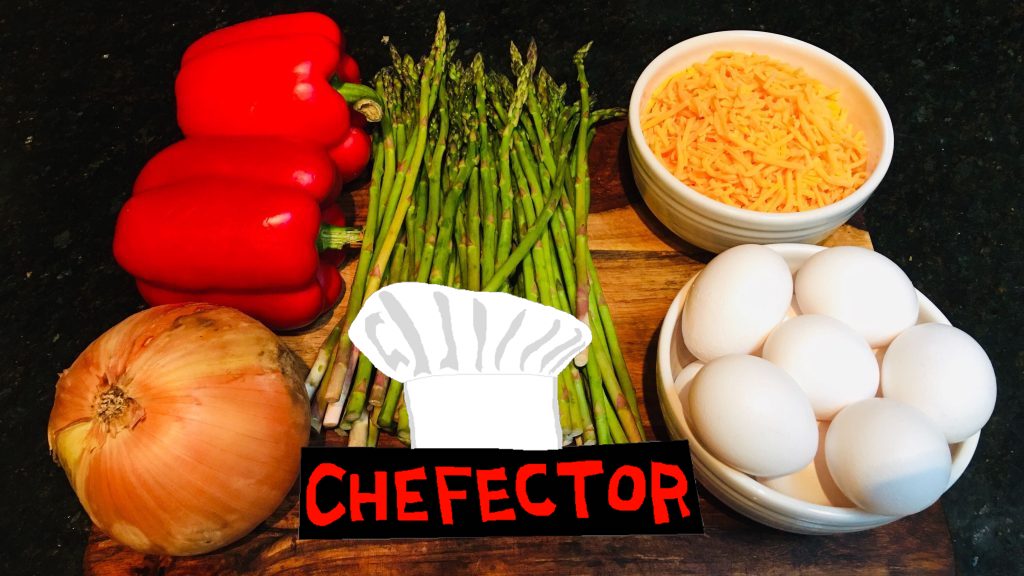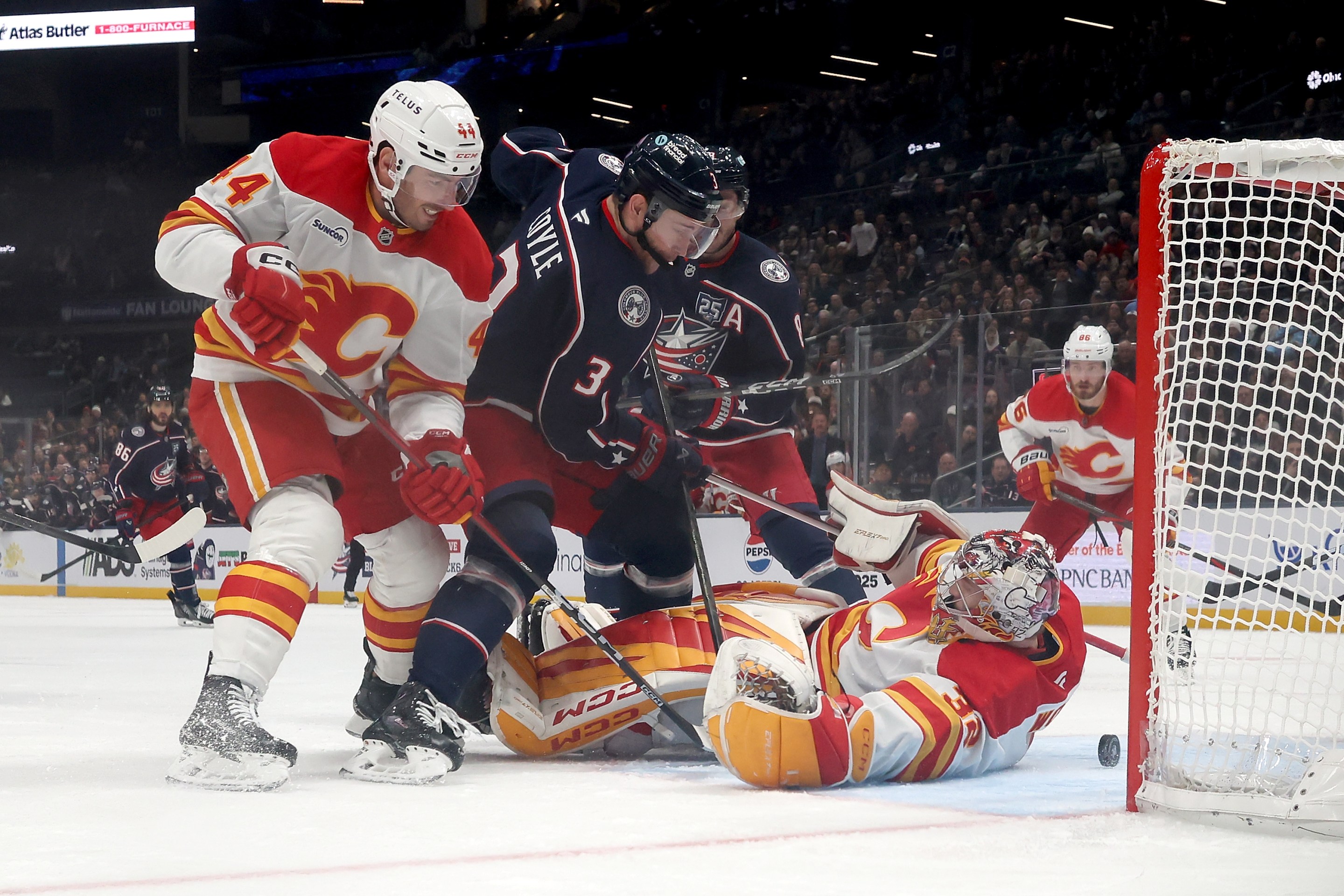I don't know what you have in your kitchen. I mean I sort of take for granted that it has, like, a sink, and probably a refrigerator. But as far as foodstuffs go, it is a mystery to me. What I know is that, at pretty much any given moment, my kitchen has the ingredients to make a frittata in it, because you can make a frittata with, well, maybe not anything, but with lots of things.
That's no minor feature in this, The Year Of Hell. I used to like grocery shopping. In a given week, it used to be one of my favorite pastimes; I did it too often, in fact, and too extravagantly, and at intervals we'd have to make a concerted effort at cutting back after looking at the ruin I was making of our budget. Now that the supermarket is no longer a festival of goodies but rather a militantly regimented prophylaxis hellscape, I dread going there. Now I try to avoid it. Now, when I do go, I try to plan and buy a week's worth of groceries so that I won't have to go back for a while. This doesn't really work—it never works—for me, an incredibly disorganized person with cataclysmic ADHD Brain; this means that, once a week or so, I enter the late-afternoon pre-dinner period worrying because I accidentally forgot to perform some number of preparatory steps necessary to whatever insane dinner I'd wrongly thought I had the capacity to plan several days in advance. And this is when, reliably, I can open the refrigerator, peer around for a few seconds, and realize that for all my disorganization and chaos, I have the means to throw together a perfectly delicious frittata.
A frittata, for the unacquainted, is an egg preparation that you cook in a pan. It is eggs and Stuff, usually vegetables, sometimes meat, often plus cheese. It is different from an omelet because it involves no folding or (in this method) flipping; it is Italian cooking rather than French, with all the relative chill-ness and lack of fussiness that distinction might seem to imply. It is much larger than an omelet, because it is the size of your entire pan; this makes it a good meal for more than one person. You eat it cut into slices like a pie, but unlike a quiche, it does not include a pie crust, which is nice, because making pie crust is the worst thing you can do.
Anyway, maybe you, too, have found yourself going "Oh shit, I don't know what I'm going to make for dinner tonight" during this endless pandemic, and dreading a trip to the store, and peeking into your fridge with an eye toward how you might be able to cobble whatever you find in there together into something deliberate-seeming and tasty. I recommend you make a frittata! Let's make a frittata.
The first thing to do is to raid your kitchen. You are looking for three ingredients, here, which the Ancients knew as "The Frittata Triad."
You will need eggs, probably somewhere between four and eight of them, depending on how big your skillet is. My skillet, an enameled cast-iron job with sloped sides, is 12 inches across at the rim, and I usually wind up using six eggs, except for the time that I got spiral-eyed and used way too much vegetable stuff and cheese and then there wasn't really any room leftover for more than a hilariously tiny amount of egg basically drizzled like so much yellow dressing across the top of a skillet crammed full of blistered vegetables and cheese. It still tasted great. Stop attacking me.
If you also happen to have some fatty liquid unsweetened milk product (cow or other)—whole milk, half-and-half, heavy cream, probably not cottage cheese—that will be fine, and will yield a noticeably richer and more velvety frittata. For the purposes of this internet instructional article we will classify said milk product as "eggs." It's not necessary. If you have eggs, you have fulfilled the "eggs" part of the Triad. (Your milk product's provisional "eggs" classification only goes so far, here: If you do not have actual chicken eggs, you cannot pull out your lil' half gallon of soy milk and be like, "Ah. The famous 'eggs.' Now to make a frittata with this.")
You will need cheese. In happier times you might have had easier access to a variety of cheeses and could pick your favorite. A modestly sharp gruyère, shredded, is a perfect cheese for a frittata, or for basically any other preparation that involves heating cheese: It melts beautifully and tastes dang good. A medium cheddar is great. The fancy grocery store across town from my house used to sometimes have these little eight-ounce bags of shaved Asiago and Parmigiano-Reggiano that were just wonderful. I really miss brie, man. Not in a frittata, just in general, since we are on the subject of which cheeses are good.
Anyhow, your frittata cheese needn't be melty or exciting. If all you have is the tub of grated parmesan in the back of the refrigerator that you haul out once a week to make Prego Night marginally less depressing, that will do nicely. Hell, for that matter, you can probably use a couple of slices of American cheese, if that's what you have.
The third ingredient you'll need for your frittata is pretty much whatever vegetable or vegetable-ish foodstuffs you can find in your kitchen, unless all you have is iceberg lettuce. (If all you have is iceberg lettuce, that's fine in the broadest sense: Use your other two frittata ingredients to prepare a nice cheese omelet or some cheesy scrambled eggs, and save the lettuce for the next time you make a sandwich.) Some fresh, crispy, green vegetables would be great, pretty much regardless of which ones they are. Chard leaves, with the thick fibrous stalks removed, would be absolutely incredible, but so would, like, some regular broccoli crowns. Failing that, do you have a couple of big onions in a bowl on the counter or in a net bag in the pantry or whatever? These will also make for a bitchin' frittata. A handful of potatoes will be great, even as this edges you into tortilla española territory. Can you get no closer to fulfilling the "vegetable or vegetable-ish foodstuffs you can find in your kitchen" requirement than unearthing a dusty can or two of sad beans from the back of a cabinet or propping up the corners of the couch? By God, you will make a frittata with those damn canned beans, and it will be delicious.
The point here is that you do absolutely need some vegetal action for your frittata. Otherwise you're kind of just making scrambled eggs. At the absolute most you might be making a cheese omelet. There's nothing wrong with making scrambled eggs, or a cheese omelet! If you would like to have some scrambled eggs, or a cheese omelet, I think you should. You deserve it. But if anybody walks up behind you while you are having your scrambled eggs or your cheese omelet and is like "That smells good, what are you having" and you are like "I am having the exotic 'frittata,' based off of the instructions I read on Defector dot com," that will be a violation of the covenant between us, and I will not forget it.
You can decide for yourself just how much vegetable matter you want in your frittata. I like a nice thick frittata; I like for it to be filled with lots of stuff. So I use a lot of vegetables, and then sometimes I end up with a comical misadventure like the one detailed above. Personally, based on what I have learned about you over our long years of association, I judge that the quantity of vegetables that would give you a hearty double-handful of vegetables is the right amount of vegetables. Perhaps I'm wrong! Perhaps I never knew you at all. Only you can be the judge of this.
In addition to your Frittata Triad, you will need some kind of cooking fat. Olive oil or butter or rendered pancetta fat or, what the hell, vegetable oil. Also some fresh herbs! I don't give a damn which kind!* I am not including these items in the essential ingredients, because frankly "Frittata Triad" sounds cooler than "Frittata Quintet."
*Not rosemary, it's too tough and the aroma too overbearing for this. Beyond that, I don't give a damn!
Preheat your oven to 400 degrees, and set an oven-proof skillet over medium heat on the stovetop so that it can get good and hot for the next few minutes while you attend to some other frittata chores.
Now you'll need to do some stuff to your ingredients. You'll need to chop your plant-life into fork-sized pieces. Eventually it's going to be cooked into a big, basically pie-like mass, that you will be slicing that pie-like mass into wedges, much like you would if it were an actual pie. This will be much less annoying if there are not whole entire friggin' zucchinis just sort of lodged into the congealed egg. Frankly I do not think you really needed this explained to you!
A few veg-specific notes. Cooking greens can just get sliced. Hack off and throw away the tough ends of asparagus spears, then cut the rest into, oh, two-inch pieces. Potatoes are great sliced thin like chips, but cooking those slices in a hot pan is an incredible pain in the ass if you haven't soaked them overnight and then allowed them to dry completely beforehand, so I recommend dicing them. Sliced onions are more fun than diced onions. Bell peppers, on the other hand, are better diced. Slice scallions at an angle so that they look jaunty and cool. Uh, drain the liquid out of canned beans and run them under a cold faucet for a few seconds.
Next up, shred that cheese. Also beat the eggs. About the egg beating: You are not looking for perfect homogeneity here. It's the end of the world; you can get by with a charming and rakish state of informality, and that's what I recommend. Beat the eggs (as well as whatever milk substance you've shoehorned into "egg" here) until the yolks and whites are just combined. Apparently a thing cooks sometimes do in certain parts of Italy is they separate the egg whites, beat them separately, and then recombine them with the yolks. I regard this as madness, and will never do it. Chop the herbs.
By now your skillet should be very damn hot. That's good! Chuck a small amount of your cooking fat in there and begin blistering the absolute shit out of your vegetables. It's good to work in small batches here, for the sake of walloping these dang veggies with heat rather than steaming them in their own liquids. Sprinkle them with a pinch of salt and move them around in the pan with your implement of choice, now and again giving them a chance to sit still for a minute and pick up some browned color and caramelized flavor. Most of all, relax. Trust your senses. The vegetables will flare a bright green when they hit the heat; they'll burst with aromas. Pluck one out and eat it after a few seconds; then again 30 seconds later. When they show signs of softening but aren't quite yet fork tender, that's when to get them out; they'll soften a bit more between now and the end, all on their own. This, pals, is the absolute best kind of cooking: Loose, informal, involving a very hot pan and a trusty wooden spoon or silicone spatula and your even trustier senses and not much else. It's going to be fine. You're doing great.
If you're using more than one variety of plant-life, start with the least colorful stuff and do the greenest stuff last. In the example in the photograph up at the top of this article, I'd begin with the sliced onion and cook it until translucent and here and there browned. Then I'd get it out of the pan, give the pan a minute to return to intense heat, and do the bell pepper next. I'd cook the asparagus last and quickest, over shrieking insane heat, until it was bright green and streaked with deep brown.
At some point all of your vegetable stuff will have received this treatment: You will have cooked it to a certain deeply sexy point, then removed it from the pan. Now, lower the heat to, say, medium or medium-low, and put the vegetable stuff back in the pan, but this time all together. Give it a quick toss or two with your trusty implement, and then dump the shredded cheese over it. Within moments, if you are using melty cheese, you will see the cheese begin to, ah, melt. As you might have expected it to! I mean frankly it would be alarming if melty cheese were not melting at this point!
Anyway, once the cheese is definitely melting, go ahead and chuck most—but not all—of your chopped herbs in there, reserving a pinch for the very end. You'll smell them heating up almost instantly. That means it's time to pour your beaten egg mixture into the pan. Use your implement to very gently prod things around; don't toss or stir the frittata, just loosen things up so that the egg has some channels down through the vegetables to the surface of the pan, so that it doesn't just sit on top of the other stuff. Very quickly you should see and hear the egg beginning to cook down at the bottom and along the sides of the pan.
There are frittata preparations out there that insist on flipping the frittata and cooking the top of it directly against the pan, rather than putting it into the oven. No doubt some number of wieners will be advocating for this approach down in the comments by the time you finish reading this. Frankly I think that's friggin' nuts. Look at that damn frittata! I would sooner attempt to flip my car. You don't need to flip this thing. Just give it a minute for the bottom of it to set, then sock this whole sucker, skillet and all, into that preheated oven and set a timer for 10 minutes.
When the timer goes off, crack the oven door and eyeball your frittata. How's it look? Is the top set and maybe beginning to acquire a brown color here and there? That's great. It's fine to prod it in the center with the tip of a chopstick to see if the egg is still super runny in there; if it is, close the oven and give it another, oh, five minutes. If it's mostly set but maybe just a liiiiittle runny, I recommend hauling it out (with an oven mitt! Don't burn yourself on my account!), sticking the lid from a pot or a tent of aluminum foil over it, and letting it sit for, oh, 10 more minutes so it can cool a little and settle; the residual heat will finish off the last of that runny egg.
Your frittata is finished. Scatter that last pinch of herbs across the top. Cut yourself a slice. I have no rapturous closer, here. You turned what you had into a meal, and it tastes good and smells good and is nourishing and hot and it will keep you alive; you laid a plank and took another step, and tomorrow you can do it again. Eat slowly, chew carefully, and remember to breathe.






